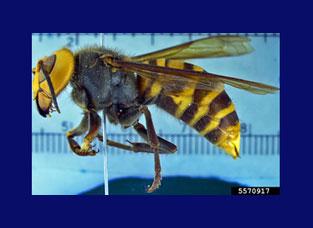Vespa mandarinia Smith, 1852 (Perrard et al. 2013)
Northern giant hornet; formerly known as Asian giant hornet or AGH (Entomological Society of America 2022)
Asia (APHIS 2020)
Was first detected in Washington State in 2019 (APHIS 2020)
Unknown (APHIS 2020)
Pest of honey bees that can cause the complete loss of colonies (APHIS 2020)

Asian giant hornet
Photo by Allan Smith-Pardo; USDA, APHIS, PPQ
Find more images
Spotlights
Distribution / Maps / Survey Status
Videos
All Resources
Selected Resources
The section below contains highly relevant resources for this species, organized by source.
Council or Task Force
Partnership
Federal Government
International Government
State and Local Government
Academic
Professional
APHIS. 2020. New Pest Response Guidelines: Vespa mandarinia [PDF, 1.15 MB]. U.S. Department of Agriculture, Animal and Plant Health Inspection Service, Plant Protection and Quarantine.
Entomological Society of America. 2022. 'Northern Giant Hornet' Adopted as Common Name for Vespa mandarinia.
Perrard A., K.M. Pickett, C. Villemant, J. Kojima, and J. Carpenter. 2013. Phylogeny of hornets: a total evidence approach (Hymenoptera, Vespidae, Vespinae, Vespa). Journal of Hymenoptera Research 32:1-15.
